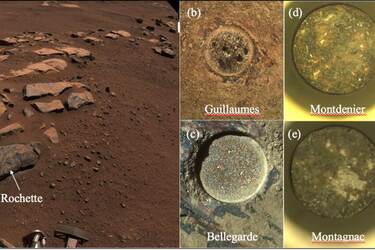Perseverance rover finds traces of organic molecules on Mars that existed about 2.3-2.6 billion years ago

A recent discovery by the Mars rover Perseverance reveals the presence of organic molecules in ten rocks that existed on Mars about 2.3-2.6 billion years ago. According to scientists, these organic substances were formed on the planet and not brought there by meteorites. Information about this is provided by Sky & Telescope.
Read also: Scientists prove that the Earth's satellite has a solid metal core
Even with the conditions on Mars today, which are unfavourable for life, scientists do not rule out the possibility of its presence in the past, when the planet was wet. Orbiting stations and rovers have discovered organic matter on Mars in different regions and in different quantities.
This research is helping scientists to study the origin, distribution, storage and evolution of these substances, which are important for establishing the possibility of past life on the planet. New discoveries of complex organic compounds were made by the Perseverance rover in the Jezero crater.
The rover can detect substances containing carbon and hydrogen, as well as carbon compounds, using the SHERLOC (Scanning Habitable Environments with Raman & Luminescence for Organics & Chemicals) Raman and fluorescence spectrograph. The scientists studied ten rocks in two formations - the younger Maaz and the older Seita. Both formations are located at the bottom of the crater and are rock outcrops that have been exposed to water and may have created favourable conditions for microorganisms.
The SHERLOC spectrograph detected emissions characteristic of single-ring aromatic compounds and polycyclic aromatic hydrocarbons. The concentration of these compounds varies from 20 to 400 picograms, with a higher concentration in the younger Maaz Formation of about 20 ppm, compared to 2 ppm in the Seita Formation.
The organic matter in both formations indicates the influence of water-related processes, but this influence was less pronounced in the Seita Formation. This indicates that organic molecules could have been formed directly on Mars rather than being brought in by meteorites. However, more detailed research is needed to establish the link between the identified compounds and possible life on Mars.
As a reminder, astronomers were able to detect a radio signal from a distant galaxy at a distance of 8.8 billion light years from Earth. It may be associated with an alien civilisation.
If you want to get the latest news about the war and events in Ukraine, subscribe to our Telegram channel!
